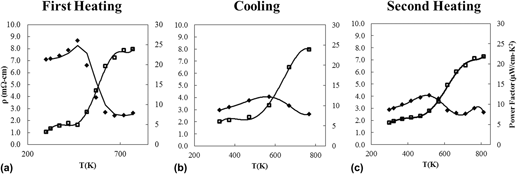Article contents
Enhanced thermoelectric performance driven by high-temperature phase transition in the phase change material Ge4SbTe5
Published online by Cambridge University Press: 15 May 2015
Abstract

Phase change materials are identified for their ability to rapidly alternate between the amorphous and crystalline phases and have large contrast in the optical/electrical properties of the respective phases. The materials are not only primarily used in memory storage applications, but also recently they have been identified as potential thermoelectric materials [D. Lencer et al., Adv. Mater.23, 2030–2058 (2011)]. Many of the phase change materials studied today can be found on the pseudo-binary (GeTe)1−x(Sb2Te3)x tie-line. While many compounds on this tie-line have been recognized as thermoelectric materials, here we focus on Ge4SbTe5, a single phase compound just off of the (GeTe)1−x(Sb2Te3)x tie-line, which forms in a stable rocksalt crystal structure at room temperature. We find that stoichiometric and undoped Ge4SbTe5 exhibits a thermal conductivity of ∼1.2 W/m K at high temperature and a large Seebeck coefficient of ∼250 μV/K. The resistivity decreases dramatically at 623 K due to a structural phase transition which leads to a large enhancement in both thermoelectric power factor and thermoelectric figure of merit at 823 K. In a more general sense, the work presents evidence that phase change materials can potentially provide a new route to highly efficient thermoelectric materials for power generation at high temperature.
- Type
- Article
- Information
- Journal of Materials Research , Volume 30 , Issue 17: Focus Issue: Advances in Thermoelectric Materials II , 14 September 2015 , pp. 2605 - 2610
- Copyright
- Copyright © Materials Research Society 2015
References
REFERENCES
- 6
- Cited by


